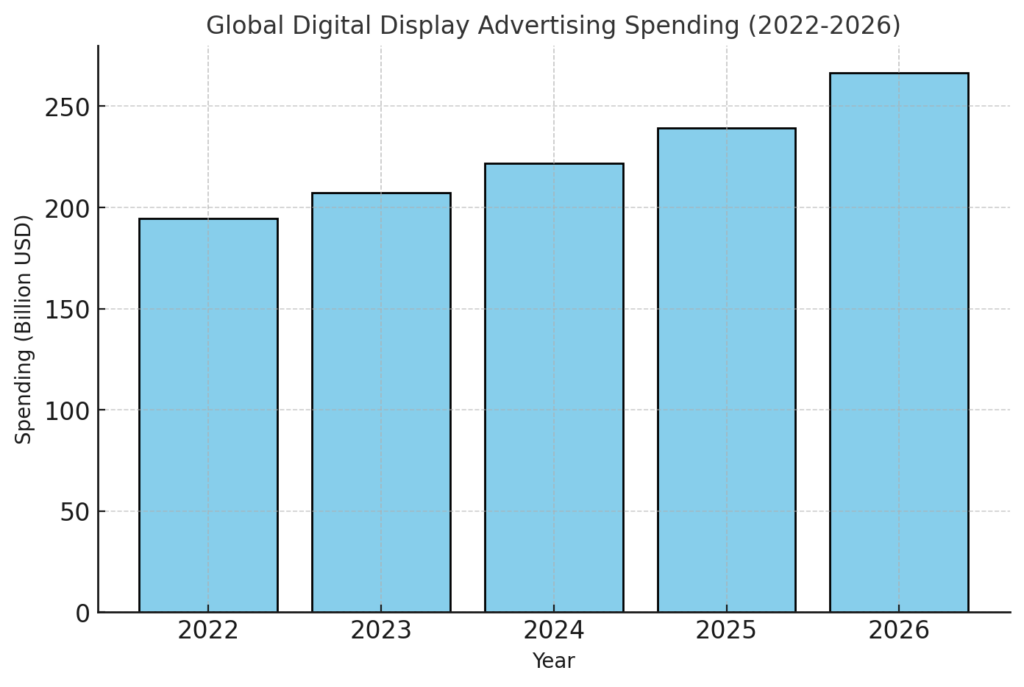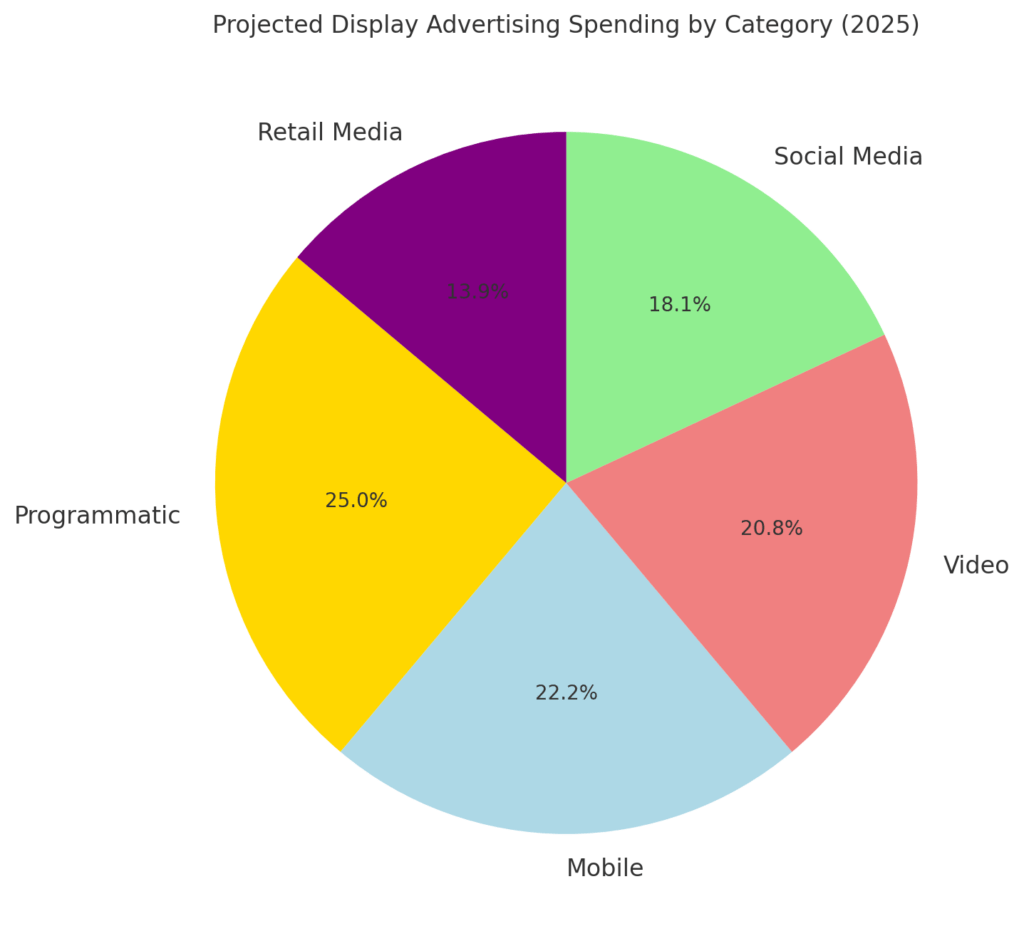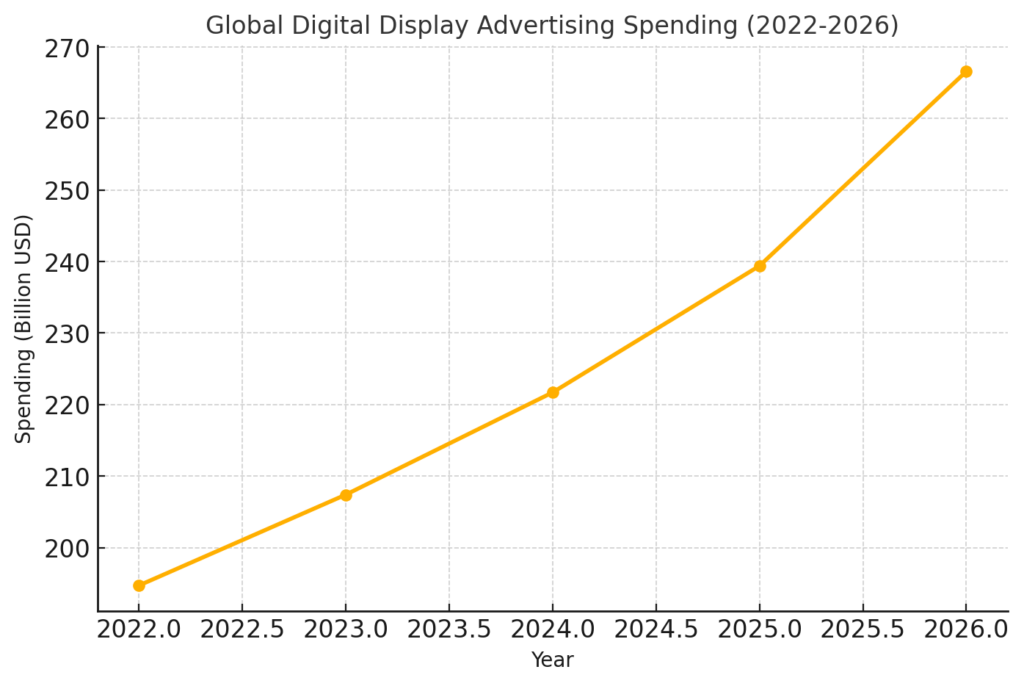
09 Mar BEST DISPLAY ADVERTISING STATISTICS 2025
Display advertising continues to be a cornerstone of digital marketing, evolving alongside consumer behaviors, technological advancements, and privacy regulations. As brands compete for attention in an increasingly saturated online space, display ads have become more sophisticated, integrating AI, programmatic bidding, and immersive formats to enhance engagement. The shift toward mobile-first experiences, video content, and social media advertising is shaping how businesses allocate budgets and measure performance. Meanwhile, challenges such as ad fatigue, rising costs, and the decline of third-party cookies are forcing marketers to rethink their strategies. As Amra and Elma look at key statistics over time and projections for 2025, it’s clear that display advertising is not only growing but also transforming in ways that demand innovation. Understanding these trends will help businesses make informed decisions about their digital advertising efforts. Below are ten of the most significant statistics highlighting where display advertising stands today and where it’s headed.
BEST DISPLAY ADVERTISING STATISTICS 2025 (Editor’s Choice)
Display advertising has evolved significantly over the years, adapting to technological advancements and changing consumer behaviors. Here are ten key statistics highlighting its growth and projected trends up to 2025:
1. Global Display Advertising Spend: In 2023, global spending on display ads reached approximately $207.4 billion, making it the leading digital ad format. This figure is expected to grow to $266.6 billion by 2026.
2. Compound Annual Growth Rate (CAGR): Digital display advertising is projected to grow at a CAGR of 15.5%, while search advertising is expected to grow at 12.2%.
3. Programmatic Advertising Dominance: By 2025, programmatic ad spending is anticipated to account for nearly 90% of digital display ads.
4. Mobile Advertising Surge: Mobile banner ad spending in the United States is projected to reach $42.3 billion by 2028, reflecting the increasing shift towards mobile platforms.
5. Video Advertising Growth: Video advertising spending is expected to surpass $120 billion globally in 2025, highlighting the growing importance of video content in display advertising strategies.
6. Retail Media Networks Expansion: Programmatic retail media display ad spending grew by 41.7% in 2024 and is projected to increase by another 29.3% in 2025. By 2026, retail media network spending is forecasted to exceed $30 billion, representing nearly 16% of all programmatic display advertising.
7. Social Media Advertising Spend: Social media ad spending is set to exceed $200 billion by 2025, indicating the platform’s significant role in display advertising.
8. Display Ads’ Contribution to Website Visits: Display ads contribute to approximately 12% of visits to websites, underscoring their effectiveness in driving traffic.
9. Digital Advertising Market Projection: The global digital advertising and marketing market is projected to reach $786.2 billion by 2026, with display advertising playing a substantial role in this growth.
10. Advertiser Budget Allocation: Approximately 16% of advertisers’ budgets are dedicated to display advertising, reflecting its importance in comprehensive marketing strategies.
These statistics illustrate the dynamic nature of display advertising and its pivotal role in the broader digital marketing ecosystem.

BEST DISPLAY ADVERTISING STATISTICS 2025 and Future Implications
BEST DISPLAY ADVERTISING STATISTICS 2025 #1. Global Display Advertising Spend
Global spending on display advertising reached $207.4 billion in 2023, solidifying its position as the dominant digital ad format. By 2026, projections suggest this figure will climb to $266.6 billion, reflecting advertisers’ growing reliance on visual-based marketing. As brands shift toward digital ecosystems, display ads will continue integrating advanced targeting capabilities, including AI-driven personalization. The increasing adoption of rich media formats such as interactive banners and dynamic ads will further fuel engagement. With ad budgets increasingly prioritizing programmatic and mobile-first strategies, businesses that fail to optimize their display campaigns may struggle to keep pace. Additionally, regulatory changes around data privacy could shape how display ads are delivered, pushing companies toward more transparent and consent-based targeting. Moving forward, brands that harness AI and first-party data will likely gain a competitive edge in the evolving landscape.
BEST DISPLAY ADVERTISING STATISTICS 2025 #2. Compound Annual Growth Rate (CAGR)
The digital display advertising market is projected to grow at a CAGR of 15.5%, outpacing search advertising, which is estimated at 12.2%. This growth highlights the increasing importance of visual storytelling and immersive ad formats. As consumer attention spans shorten, static ads will likely be replaced by motion graphics and video-based display formats to maintain engagement. Advertisers investing in programmatic display will benefit from real-time optimization, allowing for better performance tracking and cost efficiency. However, this rapid expansion also means increased competition, requiring brands to refine their creative strategies and audience segmentation. The rise in display ad spending will also encourage publishers to enhance their ad inventory, potentially leading to better ad placements and user experiences. Looking ahead, companies that combine creative storytelling with data-driven insights will dominate the digital display space.
BEST DISPLAY ADVERTISING STATISTICS 2025 #3. Programmatic Advertising Dominance
By 2025, nearly 90% of digital display advertising is expected to be programmatic, underscoring the shift toward automated ad buying. This transition allows advertisers to leverage real-time bidding, ensuring that ads reach the right audience at the right time. The efficiency of programmatic advertising minimizes wasted ad spend and increases ROI, making it an essential tool for marketers. With machine learning and AI playing a crucial role in programmatic strategies, ad targeting is expected to become even more precise. However, concerns around brand safety, ad fraud, and transparency persist, prompting advertisers to demand more stringent verification processes. The dominance of programmatic will also push agencies and brands to prioritize contextual targeting in response to tightening data privacy regulations. As the industry moves forward, companies that build trust with consumers while maintaining high-performing automated campaigns will stay ahead.
BEST DISPLAY ADVERTISING STATISTICS 2025 #4. Mobile Advertising Surge
Mobile banner ad spending in the U.S. is projected to reach $42.3 billion by 2028, reflecting the increasing reliance on smartphones for digital interactions. As consumers continue shifting toward mobile browsing and app usage, advertisers must optimize display ads for smaller screens. Responsive ad formats and mobile-first creative strategies will be critical for capturing engagement in a competitive environment. The rise of in-app advertising is also shaping the mobile display landscape, as brands look for non-intrusive yet effective ways to reach users. With advancements in 5G and mobile connectivity, rich media and interactive ad formats will likely see wider adoption. However, mobile ad blockers and user fatigue remain challenges, requiring brands to focus on relevancy and personalization. The future of mobile display advertising will depend on balancing seamless user experiences with high-impact ad placements.
BEST DISPLAY ADVERTISING STATISTICS 2025 #5. Video Advertising Growth
Video advertising is projected to surpass $120 billion globally in 2025, highlighting the shift from static display ads to more dynamic formats. With social media platforms and streaming services driving video consumption, advertisers are increasingly prioritizing video content. Short-form videos, interactive video ads, and AI-powered recommendations will enhance viewer engagement. As video becomes the preferred content format, traditional banner ads may struggle to maintain effectiveness unless integrated into interactive or hybrid formats. The push for vertical video and mobile-friendly designs will continue as platforms like TikTok, Instagram Reels, and YouTube Shorts gain traction. However, video ad production costs and competition for user attention will present challenges for smaller advertisers. Moving forward, brands that craft compelling narratives and leverage data-driven video placements will see the most success in the evolving display ad landscape.

BEST DISPLAY ADVERTISING STATISTICS 2025 #6. Retail Media Networks Expansion
Programmatic retail media display ad spending grew by 41.7% in 2024 and is expected to rise another 29.3% in 2025. Retail media networks, which allow brands to advertise directly on e-commerce platforms, are gaining momentum as consumer shopping habits evolve. Companies like Amazon, Walmart, and Target are leading the charge, offering advertisers access to high-intent shoppers. This shift means traditional display advertising on third-party sites may become less effective compared to retail-native placements. As more brands allocate budgets toward retail media, we can expect enhanced targeting capabilities and more seamless integration of display ads within online shopping experiences. However, smaller brands may face higher costs when competing against larger retailers for ad placements. Looking ahead, those who invest in first-party data strategies will gain a competitive advantage in this rapidly growing ad sector.
BEST DISPLAY ADVERTISING STATISTICS 2025 #7. Social Media Advertising Spend
Social media ad spending is expected to exceed $200 billion by 2025, reinforcing the dominance of platforms like Facebook, Instagram, TikTok, and LinkedIn. Display advertising within social media is evolving, with AI-driven targeting and immersive ad formats such as augmented reality (AR) and interactive polls. As consumers increasingly engage with short-form video content, brands must adapt their display ad strategies to match platform-specific trends. The competition for ad space is intensifying, requiring businesses to invest in high-quality creative assets to stand out. Privacy changes, such as Apple’s App Tracking Transparency (ATT), continue to reshape how social media ads are targeted and measured. Brands that prioritize community-driven advertising and leverage social commerce will maximize ROI. The future of display ads on social platforms will hinge on personalized experiences and seamless e-commerce integration.
BEST DISPLAY ADVERTISING STATISTICS 2025 #8. Display Ads’ Contribution to Website Visits
Display ads currently contribute to about 12% of website visits, proving their effectiveness in driving traffic. This statistic emphasizes the importance of display advertising in brand awareness and conversion strategies. While search and social media advertising often get more attention, well-placed display ads remain a crucial part of the digital marketing mix. Advertisers will need to refine their targeting tactics to ensure that display ads are not only attracting clicks but also leading to meaningful engagement. As AI-driven contextual targeting improves, display ads will become more relevant to users, potentially increasing conversion rates. However, banner blindness and ad fatigue remain concerns, pushing marketers to experiment with new creative approaches. Moving forward, brands that balance visibility with relevance will see sustained success in display advertising performance.

BEST DISPLAY ADVERTISING STATISTICS 2025 #9. Digital Advertising Market Projection
The global digital advertising market is projected to reach $786.2 billion by 2026, with display advertising playing a major role in that growth. This rapid expansion signals the increasing reliance on digital channels as traditional advertising declines. Emerging technologies such as AI, machine learning, and blockchain will further shape how display ads are bought, optimized, and measured. As brands shift toward omnichannel marketing, integrating display ads across multiple touchpoints will become more important. The growing demand for personalization will push advertisers to leverage real-time data and dynamic creative optimization. However, rising competition and regulatory changes around cookies and consumer data will require a shift toward privacy-centric advertising solutions. Companies that innovate while maintaining transparency with consumers will thrive in this evolving market.
BEST DISPLAY ADVERTISING STATISTICS 2025 #10. Advertiser Budget Allocation
Approximately 16% of advertisers’ budgets are dedicated to display advertising, demonstrating its continued relevance in digital marketing strategies. As more brands diversify their digital spend, display ads remain a critical tool for increasing brand awareness and retargeting potential customers. The introduction of AI-driven creatives and dynamic ad formats is making display ads more effective than ever. With the decline of third-party cookies, advertisers are investing in first-party data strategies to maintain ad performance. Contextual targeting is also gaining traction as privacy concerns reshape the industry. While newer ad formats like CTV (connected TV) and digital out-of-home (DOOH) advertising grow, display ads will still be a foundational element of digital campaigns. Moving forward, businesses that integrate display ads with cross-channel strategies will see the best results.
The Future of Display Advertising: Innovation and Adaptation
Display advertising is evolving at an unprecedented pace, driven by advancements in AI, programmatic technology, and changing consumer behaviors. With spending expected to surpass $266.6 billion by 2026, brands must refine their strategies to remain competitive in an increasingly crowded digital landscape. The rise of mobile, video, and social media advertising presents both opportunities and challenges, requiring businesses to embrace dynamic formats and data-driven targeting. Privacy regulations and the decline of third-party cookies will push advertisers toward first-party data strategies and contextual targeting. Meanwhile, programmatic advertising is becoming the standard, ensuring more efficient ad placements and higher returns on investment. As display advertising continues to adapt, brands that prioritize innovation, audience relevance, and seamless integration across digital channels will see the most success. The future belongs to those who can balance creativity with technology while respecting consumer privacy and engagement preferences.
Sources:
- https://keywordseverywhere.com/blog/display-advertising-stats
- https://www.wordstream.com/blog/ws/2022/04/19/digital-marketing-statistics
- https://cropink.com/advertising-statistics
- https://www.statista.com/topics/11351/display-advertising-in-the-us
- https://cropink.com/advertising-statistics
- https://basis.com/blog/2025-programmatic-advertising-trends-to-know
- https://cropink.com/advertising-statistics
- https://www.analyticodigital.com/blog/the-evolution-of-display-advertising-trends-and-predictions
- https://www.seo.com/blog/digital-marketing-statistics
- https://growmyads.com/google-display/statistics

